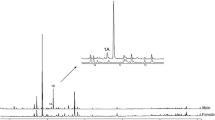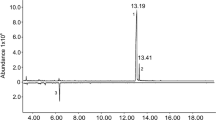Abstract
The nitidulid beetle Lobiopa insularis is an important pest of strawberry crops in the United States and Brazil. Both larvae and adults feed on ripe strawberries, causing 20–70% loss in production during serious infestations. Aiming at the development of efficient, clean, and highly specific pest management systems, semiochemicals, especially pheromones, are particularly useful. Analyses of the extracts of both males and females obtained from aeration of live beetles showed the presence of three male specific compounds, 2-nonanone, 2-undecanone, and 2-undecanol (in an enantiomeric ratio of S:R = 3.5:1). This is the first record of ketones and an alcohol as pheromone components in Nitidulidae. These compounds were emitted by males in amounts of 0.3:6:1.5 ng per insect within 24 h (1:30:3), respectively, during the scotophase, indicating nocturnal sexual activity. Field tests with pitfall traps containing different mixtures of compounds and ripe strawberries as a co-attractant summed up to five treatments with 25 replications. As a result, 59% males and 41% females (1:0.7) were caught, indicating the L. insularis pheromone to cause aggregation of both sexes. Results of the field tests showed that the attractivity of the binary mixture of ketones (T3) differed from the control (T5), from traps with 2-undecanone alone (T4), and from the mixture of 2-undecanone and racemic 2-undecanol (T2). Moreover, the activity of the ternary mixture of compounds (T1) was not different from that of T3, indicating that the racemic alcohol did not positively influence trap catches. In future applications, a mixture of synthetic strawberry-derived compounds that are attractive to L. insularis may substitute rapidly decaying fruit in the field, maintaining catches for longer periods. Because of its efficiency and low cost, a mixture of 2-undecanone and 2-nonanone is recommended to catch adult L. insularis in the field.





Similar content being viewed by others
References
Almenar E, Catala R, Hernandez-Muños P, Gavara R (2009) Optimization of an active package for wild strawberries based on the release of 2-nonanone. Food Sci Technol-LEB 42:587–593
Ayres M, Ayres JM, Ayres DL, Santos AS (2007) Bioestat 5.0 - Aplicações estatísticas nas áreas das ciências biológicas e médicas. Belém, PA, pp 364.
Bartelt RJ, Dowd PF, Vetter RS, Shorey HH, Baker TC (1992) Responses of Carpophilus hemipterus (Coleoptera: Nitidulidae) and other sap beetles to the pheromone of C. hemipterus and host-related coattractants in California field tests. Environ Entomol 21:1143–1153
Bartelt RJ, Carlson DG, Vetter RS, Baker TC (1993) Male-produced aggregation pheromone of Carpophilus mutilatus (Coleoptera: Nitidulidae). J Chem Ecol 19:107–118
Bernardi D, Botton M, Nava DE, Zawadneak MAC (2015) Guia para a identificação e monitoramento de pragas e seus inimigos naturais em morangueiro, 1st edn. Embrapa Clima Temperado, p 46
Bortoli LC, Machota Júnior R, Botton M (2014) Biologia e tabela de vida de fertilidade da broca-do-morangueiro criada em dieta artificial. Pesq Agropec Bras 49:144–147
Botton M, Bernardi D, Fornari R, Machota Júnior R, Bortoli LC (2014) Bioecologia, monitoramento e controle de Lobiopa insularis (Castelnau, 1840) (Coleoptera: Nitidulidae) na cultura do morangueiro no Rio Grande do Sul. Embrapa, Circular Técnica n. 113, pp 8
Cardé RT (2014) Defining attraction and aggregation pheromones: teleological versus functional perspectives. J Chem Ecol 40:519–520
El-Sayed AM (2016) The Pherobase: Database of Pheromones and Semiochemicals
Fornari RA, Machot R Jr, Bernardi D, Botton M, Pastori PL (2013) Evaluation of damage, food attractants and population dynamics of strawberry sap beetle. Hort Bras 31:380–385
Fornazier MJ, Carmo CAS, Teixeira CP, Pereira EB (1986) Finding of the strawberry borer Lobiopa insularis in the state of Espírito Santo. EMCAPA. Comunicado Técnico n. 44, pp 3
Guimãraes AJ, Michereff FM, Ribeiro MGPM, Liz RS, Guedes IMR (2009) Ocorrência e Manejo da Broca-do-Morango no Distrito Federal. Embrapa, Comunicado Técnico n. 74, pp 5
Hillbur Y, Celander M, Baur R, Rauscher S, Haftmann J, Franke S, Francke W (2005) Identification of the sex pheromone of the swede midge, Contarinia nasturii. J Chem Ecol 31:1807–1828
Jardim ANO, Caldas ED (2012) Brazilian monitoring programs for pesticide residues in food – Results from 2001 to 2010. Food Control 25:607–616
Kazlauskas RJ, Weissfloch ANE, Rappaport AT, Cuccia LA (1991) A rule to predict which enantiomer of a secondary alcohol reacts faster in reactions catalyzed by cholesterol estarase, lipase from Pseudomonas cepacia, and lipase from Candida rugosa. J Org Chem 56:2656–2665
Kelts CA (2005) Evaluation of attractants and monitoring for sap beetle control in strawberries. Thesis for Master in Sciences - University of Florida, Florida, p 88 http://ufdcimages.uflib.ufl.edu/UF/E0/01/20/62/00001/kelts_c.pdf
Loughner RL, Loeb GM, Demchak K, Schloemann S (2007) Evaluation of strawberry sap beetle (Coleoptera: Nitidulidae) use of habitats surrounding strawberry plantings as food resources and overwintering sites. Environ Entomol 36:1059–1065
MAPA - Ministério da Agricultura, Pecuária e Abastecimento (2017). AGROFIT: sistema de agrotóxicos fitossanitários http://agrofit.agricultura.gov.br/agrofit_cons/principal_agrofit_cons
Myers L (2016) Sap beetles of Florida. University of Florida. http://entnemdept.ufl.edu/creatures/field/corn/sap_beetles.htm
Ohtaki T, Akasaka K, Kabuto C, Ohrui H (2005) Chiral discrimination of secondary alcohols by both 1H-NMR and HPLC after labeling with a chiral derivatization reagent, 2-(2,3-Anthracenedicarnoximide)cyclohexane carboxylic acid. Chirality 17:S171–S176
Potter MA, Price JF, Habeck DH, Schuster DJ, McCord E Jr (2013) A survey of sap beetles (Coleoptera: Nitidulidae) in strawberry fields in west central Florida. Fla Entomol 96:1188–1189
Roe RM (2004) Method of repellency insects. US patent 6:437,001
Rondon SI, Price JF, Cantliffe DJ (2014) Sap beetle (Coleoptera: Nitidulidae) Management in Strawberries. University of Florida, Horticultural Sciences Department, n. HS993, 2. rev
Salles LAB, Williams RN (1986) Broca-do-morango (Lobiopa insularis). Embrapa-UEPAE. Documentos n. 17, pp 10
Scott A (2002) Insect repellent designed from tomatoes. Chem Week 164:30
Silverstein RM, Bassler GC, Morril TC (1991) Spectrometric identification of organic compounds, 5th edn. Wiley, New York, p 512
Torto B, Arbogast RT, Alborn H, Alonso S, van Englesdorp D, Boucias D, Tumlinson JH, Teal PEA (2007) Composition of volatiles from fermenting pollen dough and attractiveness to the small hive beetle Aethina tumida, a parasite of the honeybee Apis mellifera. Apidologie 38:380–389
Vidal DM, Fonseca MG, Zarbin PHG (2010) Enantioselective synthesis and absolute configuration of the sex pheromone of Hedypathes betulinus (Coleoptera: Cerambycidae). Tetrahedron Lett 51:6704–6706
Zarbin PHG, Ferreira JTB, Leal WS (1999) Metodologias gerais empregadas no isolamento e identificação estrutural de feromônios de insetos. Quim Nova 1999:263–268
Acknowledgements
The authors would like to thank Marcelo Leschnhak for allowing the field tests and collections of L. insularis in his property, Dr. Maurício Osvaldo Moura for the statistical analyses, the Conselho Nacional de Desenvolvimento Científico e Tecnológico (CNPq), the Semioquímicos na Agricultura (INCT), the Coordenação de Aperfeiçoamento de Pessoal de Nível Superior (CAPES), and the Fundação Araucária (FA) for financial support.
Author information
Authors and Affiliations
Corresponding author
Rights and permissions
About this article
Cite this article
Moliterno, A.A.C., Martins, C.B.C., Szczerbowski, D. et al. The Male Produced Aggregation Pheromone of a Strawberry Sap Beetle, Lobiopa insularis (Coleoptera: Nitidulidae). J Chem Ecol 43, 550–556 (2017). https://doi.org/10.1007/s10886-017-0851-y
Received:
Revised:
Accepted:
Published:
Issue Date:
DOI: https://doi.org/10.1007/s10886-017-0851-y




